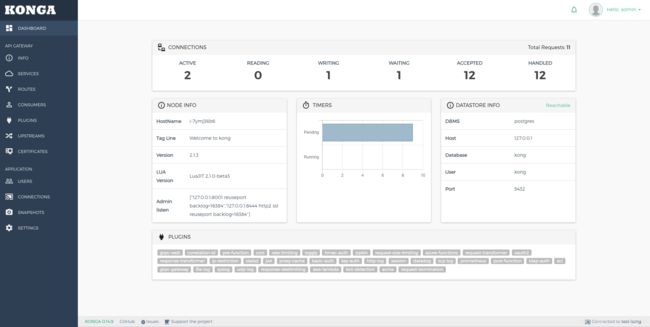微服务 API 网关 -Kong 详解
一、概述
Kong是一个clould-native、快速的、可扩展的、分布式的微服务抽象层(也称为API网关、API中间件或在某些情况下称为服务网格)框架。更确切地说,Kong是一个在Nginx中运行的Lua应用程序,并且可以通过lua-nginx模块实现。Kong不是用这个模块编译Nginx,而是与OpenResty一起发布,OpenResty已经包含了lua-nginx-module。OpenResty 不是 Nginx的分支,而是一组扩展其功能的模块。
这为可插拔架构奠定了基础,可以在运行时启用和执行Lua脚本(称为“插件”)。因此,我们认为Kong是微服务架构的典范:它的核心是实现数据库抽象,路由和插件管理。插件可以存在于单独的代码库中,并且可以在几行代码中注入到请求生命周期的任何位置。Kong作为开源项目在2015年推出,它的核心价值是高性能和可扩展性。
Kong被广泛用于从初创企业到全球5000家公司以及政府组织的生产环境中。
如果构建Web、移动或IoT(物联网)应用,可能最终需要使用通用的功能来实现这些应用。Kong充当微服务请求的网关(或侧车),通过插件能够提供负载平衡、日志记录、身份验证、速率限制、转换等能力。
一个service可以创建多个routes,routes就相当于前端配置,可以隐藏业务真正的接口地址,service指定后端真实的转发接口地址,在kong上进行认证/鉴权/日志/分析/监控等控制。
二、部署kong
1、配置yum源
sudo yum update -y
sudo yum install -y wget
wget https://bintray.com/kong/kong-rpm/rpm -O bintray-kong-kong-rpm.repo
export major_version=`grep -oE '[0-9]+\.[0-9]+' /etc/redhat-release | cut -d "." -f1`
sed -i -e 's/baseurl.*/&\/centos\/'$major_version''/ bintray-kong-kong-rpm.repo
sudo mv bintray-kong-kong-rpm.repo /etc/yum.repos.d/
sudo yum update -y
sudo yum install -y kong
2、 数据库安装
Kong支持PostgreSQL v9.5+和Cassandra 3.x.x作为数据存储。
官网地址:https://www.postgresql.org/download/linux/redhat/
yum install -y https://download.postgresql.org/pub/repos/yum/reporpms/EL-7-x86_64/pgdg-redhat-repo-latest.noarch.rpm
yum install -y postgresql11-server
/usr/pgsql-11/bin/postgresql-11-setup initdb
systemctl enable postgresql-11
systemctl start postgresql-11
创建需要的数据库和用户
# 登录psql
sudo su postgres
psql
# 创建数据库,官方默认无密码,此处我使用密码
# CREATE USER kong; CREATE DATABASE kong OWNER kong;
CREATE USER kong with password 'kong';
CREATE DATABASE kong OWNER kong;
grant all privileges on database kong to kong;
#此时也要把postgres的密码设置一下,不然待会开启md5认证之后,这个用户没有密码就不能登录了。
#然后我们需要复原配置重启数据库才可以。所以我们要把密码设置一下。
ALTER USER postgres WITH PASSWORD 'postgres';
# 修改安全配置(为了使用密码登录)
vim /var/lib/pgsql/11/data/pg_hba.conf
# METHOD指定如何处理客户端的认证。常用的有ident,md5,password,trust,reject
# ident是Linux下PostgreSQL默认的local认证方式,凡是能正确登录服务器的操作系统用户(注:不是数据库用户)就能使用本用户映射的数据库用户不需密码登录数据库。
# md5是常用的密码认证方式,如果你不使用ident,最好使用md5。密码是以md5形式传送给数据库,较安全,且不需建立同名的操作系统用户。
# password是以明文密码传送给数据库,建议不要在生产环境中使用。
# trust是只要知道数据库用户名就不需要密码或ident就能登录,建议不要在生产环境中使用。
# reject是拒绝认证。
# 将peer改为md5()
# "local" is for Unix domain socket connections only
local all all md5
# IPv4 local connections:
host all all 127.0.0.1/32 ident
# IPv6 local connections:
host all all ::1/128 ident
# 重启psql
systemctl restart postgresql-11
# 登录postgre
psql -U kong
# 输入密码
# 查看帮助
\h
# 退出
\q
3、修改kong的配置文件
# 这里需要提前配置kong配置文件,默认/etc/kong/kong.conf.default
cp /etc/kong/kong.conf.default /etc/kong/kong.conf
# 修改里面的数据库配置,写入用户、密码、数据库、端口等信息
vim /etc/kong/kong.conf
[root@kong-server software]# egrep -v "^#|^$|^[[:space:]]+#" /etc/kong/kong.conf
database = postgres # Determines which of PostgreSQL or Cassandra
pg_host = 127.0.0.1 # Host of the Postgres server.
pg_port = 5432 # Port of the Postgres server.
pg_timeout = 5000 # Defines the timeout (in ms), for connecting,
pg_user = kong # Postgres user.
pg_password = kong # Postgres user's password.
pg_database = kong # The database name to connect to.
# Kong migrations
#kong migrations bootstrap [-c /path/to/kong.conf]
[root@kong-server software]# kong migrations bootstrap -c /etc/kong/kong.conf
Bootstrapping database...
migrating core on database 'kong'...
core migrated up to: 000_base (executed)
core migrated up to: 001_14_to_15 (executed)
core migrated up to: 002_15_to_1 (executed)
core migrated up to: 003_100_to_110 (executed)
core migrated up to: 004_110_to_120 (executed)
core migrated up to: 005_120_to_130 (executed)
migrating hmac-auth on database 'kong'...
hmac-auth migrated up to: 000_base_hmac_auth (executed)
hmac-auth migrated up to: 001_14_to_15 (executed)
migrating oauth2 on database 'kong'...
oauth2 migrated up to: 000_base_oauth2 (executed)
oauth2 migrated up to: 001_14_to_15 (executed)
oauth2 migrated up to: 002_15_to_10 (executed)
migrating jwt on database 'kong'...
jwt migrated up to: 000_base_jwt (executed)
jwt migrated up to: 001_14_to_15 (executed)
migrating basic-auth on database 'kong'...
basic-auth migrated up to: 000_base_basic_auth (executed)
basic-auth migrated up to: 001_14_to_15 (executed)
migrating key-auth on database 'kong'...
key-auth migrated up to: 000_base_key_auth (executed)
key-auth migrated up to: 001_14_to_15 (executed)
migrating rate-limiting on database 'kong'...
rate-limiting migrated up to: 000_base_rate_limiting (executed)
rate-limiting migrated up to: 001_14_to_15 (executed)
rate-limiting migrated up to: 002_15_to_10 (executed)
rate-limiting migrated up to: 003_10_to_112 (executed)
migrating acl on database 'kong'...
acl migrated up to: 000_base_acl (executed)
acl migrated up to: 001_14_to_15 (executed)
migrating response-ratelimiting on database 'kong'...
response-ratelimiting migrated up to: 000_base_response_rate_limiting (executed)
response-ratelimiting migrated up to: 001_14_to_15 (executed)
response-ratelimiting migrated up to: 002_15_to_10 (executed)
migrating session on database 'kong'...
session migrated up to: 000_base_session (executed)
27 migrations processed
27 executed
Database is up-to-date
#迁移过程中可能会报错,如果包认证问题,做如下修改
vim /var/lib/pgsql/11/data/pg_hba.conf
#host all all 127.0.0.1/32 ident
host all all 127.0.0.1/32 md5
#原因是postgresql设置不允许本地主机访问。(127.0.0.1允许IP连接,而不是通过套接字)
4、启动kong
#kong start [-c /path/to/kong.conf]
[root@kong-server software]# kong start -c /etc/kong/kong.conf
Kong started
[root@kong-server software]# kong health
nginx.......running
Kong is healthy at /usr/local/kong
[root@kong-server software]# netstat -lntup
Active Internet connections (only servers)
Proto Recv-Q Send-Q Local Address Foreign Address State PID/Program name
tcp 0 0 127.0.0.1:8444 0.0.0.0:* LISTEN 31050/nginx: master
tcp 0 0 0.0.0.0:8000 0.0.0.0:* LISTEN 31050/nginx: master
tcp 0 0 127.0.0.1:8001 0.0.0.0:* LISTEN 31050/nginx: master
tcp 0 0 0.0.0.0:22 0.0.0.0:* LISTEN 1453/sshd
tcp 0 0 127.0.0.1:5432 0.0.0.0:* LISTEN 30638/postmaster
tcp 0 0 0.0.0.0:8443 0.0.0.0:* LISTEN 31050/nginx: master
tcp6 0 0 ::1:5432 :::* LISTEN 30638/postmaster
udp 0 0 0.0.0.0:68 0.0.0.0:* 780/dhclient
udp 0 0 172.16.16.16:123 0.0.0.0:* 3006/ntpd
udp 0 0 127.0.0.1:123 0.0.0.0:* 3006/ntpd
udp6 0 0 fe80::5054:ff:fe94::123 :::* 3006/ntpd
udp6 0 0 ::1:123 :::* 3006/ntpd
[root@kong-server software]# curl http://localhost:8001
......
......
......
#停止:
kong stop
#重新加载:
kong reload
三、安装konga
konga为目前最先版本的kong的dashboard,由于kong-dashboard目前为更新适应新版本的kong,推荐使用konga
konga带来的一个最大的便利就是可以很好地通过UI观察到现在kong的所有的配置,并且可以对于管理kong节点情况进行查看、监控和预警,konga主要特性如下:
多用户管理
管理多个Kong节点
电子邮件异常信息通知
管理所有Kong Admin API
使用快照备份,还原和迁移Kong节点
使用运行状况检查监控节点和API状态
轻松的数据库集成(MySQL,postgresSQL,MongoDB)
1、node 安装
yum -y install git
cd /data/software && wget https://npm.taobao.org/mirrors/node/v10.16.2/node-v10.16.2-linux-x64.tar.xz
tar -xf node-v10.16.2-linux-x64.tar.xz
mv node-v10.16.2-linux-x64 node
# 修改为root的权限
chown root.root node -R
cat > /etc/profile.d/node.sh << EOF
export PATH=\$PATH:/data/software/node/bin
EOF
source /etc/profile.d/node.sh
node -v
# 安装插件
#为了在安装插件的时候速度快一点,可以更换一下镜像源
npm config set registry https://registry.npm.taobao.org
#配置后可通过下面方式来验证是否成功
npm config get registry
# 或
npm info express
#如果想还原npm仓库地址的话,只需要在把地址配置成npm镜像就可以了
npm config set registry https://registry.npmjs.org/
#有的插件还需要gcc环境,需要提前安装
yum install gcc* -y
#开始安装插件
npm install -g glup
npm install -g bower
npm install -g sails
npm install -g node-gyp
npm install -g grunt-sass
npm install -g node-sass
npm install sails-postgresql #用来支持postgresql数据库
#安装插件的时候,可能还会有问题,gyp ERR! stack Error: EACCES: permission denied, mkdir。
#如果有这样的问题 在安装插件的命令后面加上 --unsafe-perm
#就是说 npm 出于安全考虑不支持以 root 用户运行,即使你用 root 用户身份运行了,npm 会自动转成一个叫 nobody 的用户来运行,
#而这个用户几乎没有任何权限。这样的话如果你脚本里有一些需要权限的操作,比如写文件(尤其是写 /root/.node-gyp),就会崩掉了。
#为了避免这种情况,要么按照 npm 的规矩来,专门建一个用于运行 npm 的高权限用户;要么加 --unsafe-perm 参数,
#这样就不会切换到 nobody 上,运行时是哪个用户就是哪个用户,即是 root。
2、安装konga
git clone https://github.com/pantsel/konga.git
cd konga
npm install konga
#使用postgresql,创建konga用到的数据库
#需要使用postgres用户登录,要输入前文设置的密码
sudo su postgres
psql
CREATE USER konga with password 'konga';
CREATE DATABASE konga OWNER konga;
grant all privileges on database konga to konga;
3、配置
cd konga/
cp config/local_example.js config/local.js
# 配置默认数据库
vi config/local.js
models: {
connection: process.env.DB_ADAPTER || 'localDiskDb',
},
# 改成
models: {
connection: process.env.DB_ADAPTER || 'postgres', // 这里可以用‘mysql’,‘mongo’,‘sqlserver’,‘postgres’
},
# 保存
# 修改数据库默认配置
vi connections.js
postgres: {
adapter: 'sails-postgresql',
url: process.env.DB_URI,
host: process.env.DB_HOST || 'localhost',
user: process.env.DB_USER || 'konga',
password: process.env.DB_PASSWORD || 'konga',
port: process.env.DB_PORT || 5432,
database: process.env.DB_DATABASE ||'konga',
// schema: process.env.DB_PG_SCHEMA ||'public',
poolSize: process.env.DB_POOLSIZE || 10,
ssl: process.env.DB_SSL ? true : false // If set, assume it's true
},
# 保存
# 启动
cd ../
npm start
nfo:
info: .-..-.
info:
info: Sails <| .-..-.
info: v0.12.14 |\
info: /|.\
info: / || \
info: ,' |' \
info: .-'.-==|/_--'
info: `--'-------'
info: __---___--___---___--___---___--___
info: ____---___--___---___--___---___--___-__
info:
info: Server lifted in `/data/software/konga`
info: To see your app, visit http://0.0.0.0:1338
info: To shut down Sails, press <CTRL> + C at any time.
# pm2 管理
npm install -g pm2
cd konga
pm2 start app.js --name konga
pm2 logs
pm2是一个进程管理工具,可以用它来管理你的node进程,并查看node进程的状态,当然也支持性能监控,进程守护,负载均衡等功能
1、 pm2需要全局安装
npm install -g pm2
2、进入项目根目录
启动进程/应用 pm2 start bin/www 或 pm2 start app.js
重命名进程/应用 pm2 start app.js --name wb123
添加进程/应用 watch pm2 start bin/www --watch
结束进程/应用 pm2 stop www
结束所有进程/应用 pm2 stop all
删除进程/应用 pm2 delete www
删除所有进程/应用 pm2 delete all
列出所有进程/应用 pm2 list
查看某个进程/应用具体情况 pm2 describe www
查看进程/应用的资源消耗情况 pm2 monit
查看pm2的日志 pm2 logs
若要查看某个进程/应用的日志,使用 pm2 logs www
重新启动进程/应用 pm2 restart www
重新启动所有进程/应用 pm2 restart all
4、访问
地址 IP: 1338
默认用户:admin,密码:adminadminadmin
到这一步已经算是安装完成了,不过这里还有一个问题,访问到的界面是空白的,还需要一步操作。
cd kong
npm run bower-deps
这一过程要等很久,之后在访问就可以了。
配置kong的链接地址: http://localhost:8001
推荐阅读:
Kong API Gateway-用户指南 : https://github.com/cloudframeworks-apigateway/user-guide-apigateway#%E6%A1%86%E6%9E%B6%E8%AF%B4%E6%98%8E-%E4%B8%9A%E5%8A%A1
微服务 API 网关 -Kong 详解: https://xie.infoq.cn/article/ba0f7503c73b86126017c0d32
官网:https://docs.konghq.com/

